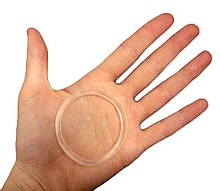Vaginal ring
[4] These hormones work mostly by stopping ovulation and thickening the cervical mucus, creating a barrier preventing sperm from fertilizing an egg.
For continuous-use contraception, users can also choose to wear the vaginal ring for the full four week cycle.
[4][7][8] Because they release estrogen, vaginal rings have an increased risk of heart attack, stroke, and other serious side effects.
[6][7] Rings are typically left in place during intercourse, and most couples report no interference or discomfort.
[11] Rings can be removed prior to intercourse, but, in the case of the contraceptive NuvaRing, only for one to three hours to maintain efficacy of birth control.
[6] It typically takes between one and two months for a user's cycle to return to normal after the use of a vaginal ring is stopped.
